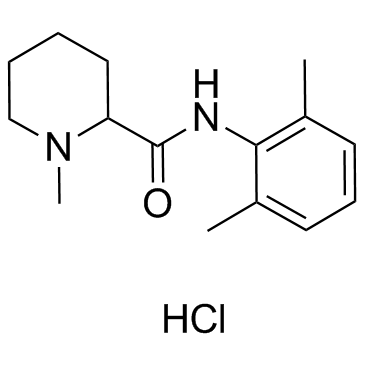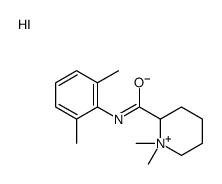1722-62-9
| Name | mepivacaine hydrochloride |
|---|---|
| Synonyms |
(±)-1-Methyl-2',6'-pipecoloxylidide monohydrochloride
Mepivacaine hydrochloride Mepivastesin N-(2,6-dimethylphenyl)-1-methylpiperidine-2-carboxamide,hydrochloride (±)-N-(2,6-Dimethylphenyl)-1-methylpiperidine-2-carboxamide Hydrochloride Scandicain 1-Methyl-2',6'-pipecoloxylidide hydrochloride Carbocaina N-(2,6-diméthylphényl)-1-méthylpipéridine-2-carboxamide chlorhydrate 1-Methyl-2',6'-pipecoloxylidide monohydrochloride N-(2,6-Dimethylphenyl)-1-methyl-2-piperidinecarboxamide Hydrochloride Mepivicaine hydrochloride N-(2,6-dimethylphenyl)-1-methylpiperidine-2-carboxamide hydrochloride Mepivacaine HCL N-(2,6-Dimethylphenyl)-1-methylpiperidin-2-carboxamidhydrochlorid N-(2,6-Dimethylphenyl)-1-methylpiperidine-2-carboxamide hydrochloride (1:1) N-(2,6-Dimethylphenyl)-1-methyl-2-piperidinecarboxamide hydrochloride (1:1) MFCD00243006 Carbocaine hydrochloride Meaverin 2-Piperidinecarboxamide, N-(2,6-dimethylphenyl)-1-methyl-, hydrochloride (1:1) EINECS 217-023-9 Mepivacaine (hydrochloride) |
| Description | Mepivacaine is a tertiary amine used as a local anesthetic.Target: Sodium ChannelMepivacaine is a local anesthetic of the amide type. Mepivacaine has a reasonably rapid onset (more rapid than that of procaine) and medium duration of action (shorter than that of procaine). Mepivacaine is used in any infiltration and regional anesthesia. It is supplied as the hydrochloride salt of the racemate [1]. Mepivacaine displayed a preferential use-dependent block of Na(v)1.8, S(-)-bupivacaine displayed a preference for TTXs Na(+) channels [2]. |
|---|---|
| Related Catalog | |
| References |
| Boiling Point | 383.1ºC at 760 mmHg |
|---|---|
| Melting Point | 255-257ºC (dec.) |
| Molecular Formula | C15H23ClN2O |
| Molecular Weight | 282.809 |
| Flash Point | 185.5ºC |
| Exact Mass | 282.149902 |
| PSA | 32.34000 |
| LogP | 3.53910 |
| Vapour Pressure | 4.52E-06mmHg at 25°C |
CHEMICAL IDENTIFICATION
HEALTH HAZARD DATAACUTE TOXICITY DATA
|
| Symbol |

GHS06 |
|---|---|
| Signal Word | Danger |
| Hazard Statements | H301 |
| Precautionary Statements | P301 + P310 |
| Personal Protective Equipment | dust mask type N95 (US);Eyeshields;Faceshields;Gloves |
| Hazard Codes | Xn: Harmful; |
| Risk Phrases | R22 |
| Safety Phrases | S22-S24/25 |
| RIDADR | UN 2811 6.1 / PGIII |
| RTECS | TK6475000 |
| HS Code | 2933399090 |
| Precursor 0 | |
|---|---|
| DownStream 1 | |
| HS Code | 2933399090 |
|---|---|
| Summary | 2933399090. other compounds containing an unfused pyridine ring (whether or not hydrogenated) in the structure. VAT:17.0%. Tax rebate rate:13.0%. . MFN tariff:6.5%. General tariff:20.0% |

